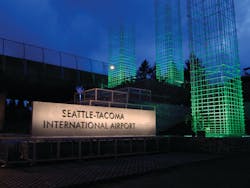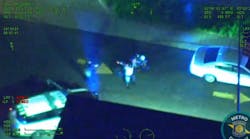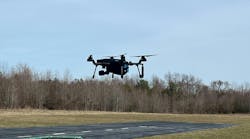Public Safety Answering Points (PSAPs) come in as many colors and flavors as the public safety agencies and the communities they serve. Most of the time, when you hear about a PSAP, it’s in reference to a traditional or one that serves a municipality, county or state. Existing right beside them, functioning in the same way, are nontraditionals. “Right now, non-traditional PSAPs are going to be universities, large schools, hospitals and airports,” explains Elizabeth “Liz” Phillips, Assistant Director, University of Kansas (KU) Public Safety Office. “We are unique in many ways and in many ways we do all the same things.” Even browsing the extensive list of PSAPs produced by the Association of Public-Safety Communications Officials (APCO), it’s hard to tell how many nontraditionals exist. “Probably more than we expect,” says Ty Wooten, Education and PSAP Operations Director, National Emergency Number Association (NENA). Wooten has unique experience in this area as he was the director at the Indianapolis International Airport for several years. “We were the primary answering point of the entire campus,” he explains. “There is an assumption they are a secondary and not a primary,” he says of non-traditionals. This is not the case many times. Non-traditionals are PSAPs functioning just like those in major cities. PSAPs like the one at KU and the Port of Seattle.
Protector of the Jayhawks
During the turmoil of the Vietnam War, University of Kansas KU), along with Kent State and UC-Berkeley administrators struggled with maintaining student safety with the unrest that rocked their campuses. With a large population of Black Panthers and Native American presence, KU needed to address the changes in their environment. The city agreed. “It was in the late 60s, early 70s that Lawrence (KS) said you aren’t giving any taxes, so you need to provide your own law enforcement,” explains Phillips. “State legislators passed a law that started the police department at the University. Then we started our own PSAP.” Phillips also mentioned that Lawrence was the pilot city for Southwestern Bell’s basic 9-1-1. Located on the main campus of KU, this non-traditional PSAP has one administrator, one supervisor, eight 9-1-1 operators with two more positions pending. In fall 2013, 27,939 students were enrolled with their campus positioned directly in the middle of a city of 92,000. The main campus is around 1,000 acres. Phillips who spoke at APCO 2013 on a panel titled, “Non-Traditional Communication Centers and NG9-1-1” told the audience, “If it walks like a duck, quacks like a duck and acts like a duck, you figure out the rest.”
One if by Air. Two if by Sea
Another non-traditional PSAP, the Port of Seattle serves not only the seaport but also Seattle-Tacoma International Airport with over 33 million people traveling through their jurisdiction every year. “While we are considered a non-tradition, we function more like a traditional,” explains Kathy McCaughan, Communications Manager. With 16 full-time dispatchers, two shift supervisors and one IT support person, the Port of Seattle PSAP is located in the airport and serves as primary for landlines and wireless calls that fall into their jurisdiction. They also serve as a secondary PSAP to cell phones for King County (WA) Sheriff’s Office. Seattle has 53 miles of seawater shoreline and the port ranks 8th largest in the U.S hosting 21,000 jobs. Sea-Tac ranked as the 15th busiest airport in the U.S. in 2012 serving 309,597 aircraft operations and moved 283,500 metric tons of air cargo. In addition, this non-traditional will be offering services to a local jurisdiction in the near future.
Population Served
“Our customers have a different dynamic,” Phillips explains. KU’s community is younger, with an average age of 22-23, has a higher education level and less of poverty issues than those facing the population served by traditional PSAPs. “Our whole community is a little different. We have kids that have never been away from home before,” she explains. “We have ones that the whole culture is strange to. All of the things that we think of as being pretty routine if you were born in the US are kind of weird.” The fact that the population is transient also affects non-traditionals with airport populations changing daily, hospitals every three to four days, and universities every three to four years, as well as, each semester. McCaughan agrees the diverse population makes serving as a non-traditional unique. “We don’t have major residential areas,” she says. “Our customers are our tenants, employees and the travelers.” These factors make non-traditional customer service unique as well.
Serving Their Needs
“We have a different customer service orientation,” says Phillips. “Not only do we handle law enforcement and 9-1-1 and emergency services, most non-traditional centers take pleasure in handling public works. We’re the only ones here 24/7 365. This is true for most hospitals and airports too. The PSAP is the only place that answers the phone all the time. A home owner doesn’t call 9-1-1 to say a pipe broke in my house. However, if the pipe breaks at the main library they are calling us.” The Port of Seattle faces the same issues. “We don’t take a ton of traffic accidents,” McCaughan explains. “We don’t tone out for house fires. A lot of the things we do are rather research intensive. We have a lot of coordination to do with TSA, Homeland Security and airport operations. Traditionals might be fairly straightforward. Ours is a lot of coordination with other entities.”
Wooten expands on this stating that non-traditionals are unique because they are specialty focused. “They are often doing things that traditional centers don’t do as a whole,” he says. “They are watching hundreds of cameras, monitoring specialized alarms on doors as well as fuel tanks. They do a ton of different things. It’s like a little city but it’s more condensed in what it is that they have to manage.”
Low Frequency High Consequence Events
“The other big thing that non-traditionals do is we have critical incidents on a daily basis,” explains Phillips. “Major sporting events and major speakers. Some of our major events would be overwhelming to the smaller PSAPS,” she states citing KU’s 2008 basketball championship where 40,000 fans poured into the streets after their win. Wooten agrees that non-traditionals are very good at dealing with and managing large scale events. “Everything from a university ramping up for a weekly football or basketball game that brings thousands of people into their area or an airport prepping for a presidential visit,” he explains. “They are very adapted to dealing with these types of high profile events. What might be a once in a lifetime event for an area happens all the time.” He explains that a president may go to a town one or two times in his presidency but he will go to the airport every time. “Low frequency high consequence events become higher frequency for non-traditions,” he says. Due to this, many non-traditional are very adapted at being involved in an emergency operations center (EOC). “There are less people, so they go into those centers more often,” he explains. “Sometimes they are the people who decide to call an EOC up.” McCaughan explains her dispatchers are subject matter experts on their area and the public they serve. “We walk it,” she explains of their jurisdiction. “It would be hard to walk the entire city of a traditional.”
A Common Mission
Along with their many strengths, non-traditionals face challenges as well. Acceptance that non-traditionals have the same needs as traditions can be a struggle. “A lot of my peers have trouble convincing administrators that they need the same kind of training and the same level of clearance,” explains Phillips. “There is really this hope among university administrators that nothing bad will ever happen here.” McCaughan agrees maintaining the skill set to handle high intensity events can be a challenge. “They are often small,” says Wooten. “They may lack the ability to get some outside training and people don’t look at them as primary PSAPs. Often people think that the 9-1-1 centers at an airport or a small university aren’t primary but that the calls go to a primary PSAP at the county and then get shuttled to that agency. That’s not always the truth.” Wooten believes that this challenge can also lead to a strength because non-traditionals may not have the resources to send their people outside the agency for training. “I worked with dispatchers, airport police and fire to develop training packages that could be used for all three,” he explains. “So dispatchers got exposure to other things that made them a better dispatcher in making training about becoming familiar with the campus or something unique on that campus.” Phillips finds the ability to recruit qualified applicants can also be a challenge.
Part of meeting the common mission of a PSAP is the ability to stay up with technology. Both KU and Port of Seattle seem to be doing well in this regard. “We are in the middle of a county-wide upgrade to Motorola P25 trunked 800,” states Phillips. The Cassidian Patriot phone system will be upgraded again to the newest version in spring 2014. The Port of Seattle is also in the middle of a major radio system upgrade with Motorola. “That will be completed by the end of first quarter 2014,” states McCaughan. “We have our own system outside King County. It will help us communicate more seamlessly with them. We’re doing a CAD upgrade in 2014 brought online in early 2015.” Phillips believes staying up and even ahead in technology is important with non-traditionals. “We have the resources and knowledge base to do it,” she says. In reference to text to PSAP, she feels, “We have to solve that problem now and we can’t wait for the 9-1-1 system to catch up. They don’t know how to talk on the phone,” she says of their community. “We need the ability to notify these kids so the technology needs to stay in front of the constituency. We have to be creative and outside the box to address issues head on.” McCaughan states the Port of Seattle’s infrastructure exists for NG9-1-1 but they’re not ready yet. “The technology is in place but the operational side has some things lacking to make it easy for 9-1-1 centers to handle text messages and transfers.” Her message to customers once it comes on-line, “Call if you can. Text if you can’t.”
“We want the non-traditionals to reach out to the traditionals and make partnerships,” expresses Phillips. “We’ve proven that it can be done and it can be done well. Make the connections and share resources.” Wooten furthers it’s about understanding what is going on at the non-traditional center. “It’s about forging relationships and getting outside our normal day to day operations and understanding those partners that surround us.” For public safety professionals working at traditional and non-traditionals alike, take a look around you, see who else is out there, figure out how to work together and build on everyone’s strengths. Residents, seaport workers, hospital visitors and the traveling public will thank you.



